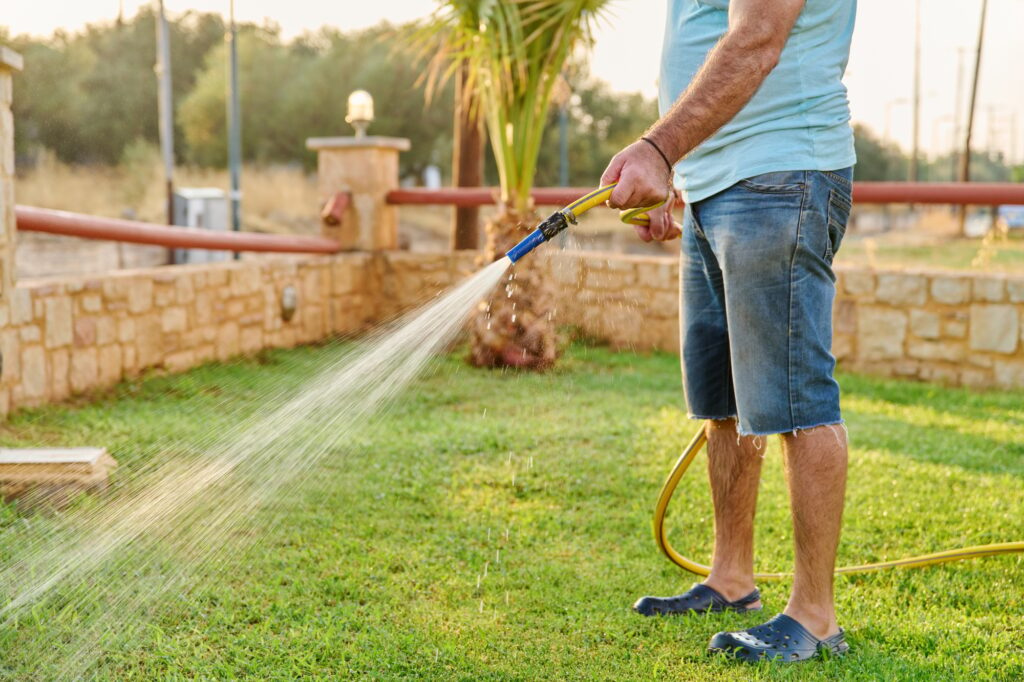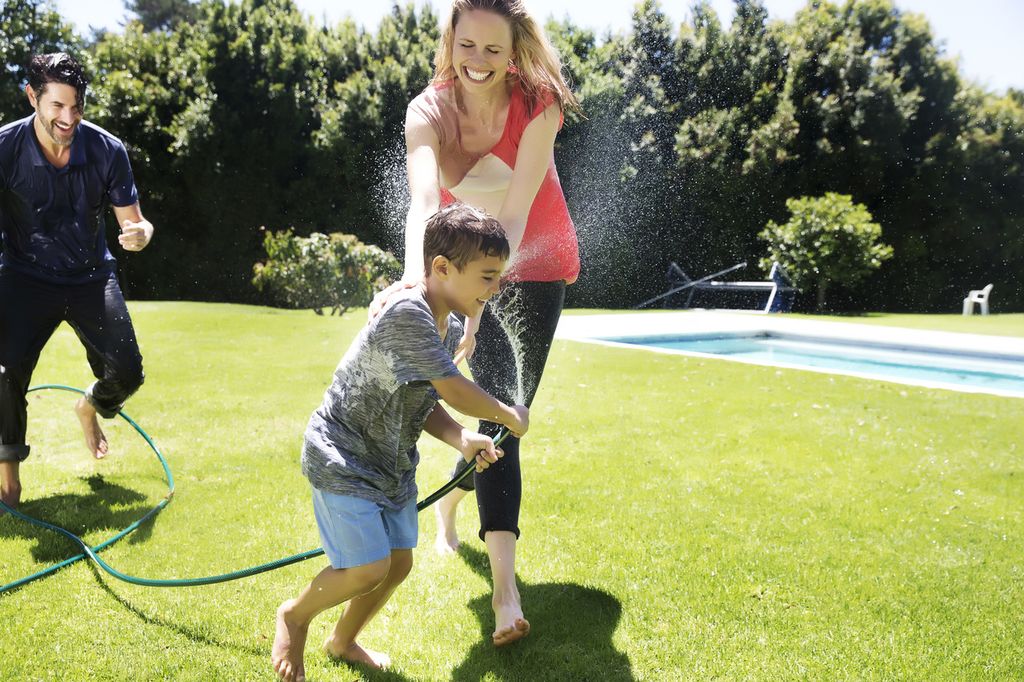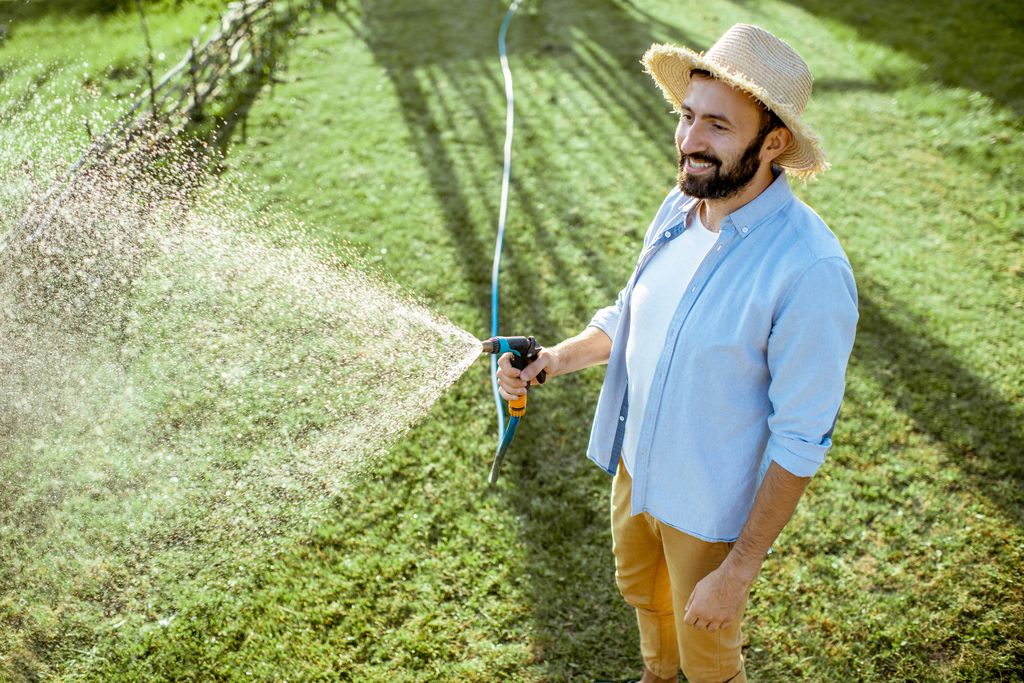You don’t need an expensive sprinkler system to keep your lawn green and healthy. Whether you’re trying to save money, conserve water, or just avoid installing a complex setup, there are plenty of simple ways to water your lawn without a sprinkler system.
Let’s walk through the best options, step by step.
This post contains affiliate links. As an Amazon Associate, I earn from qualifying purchases at no additional cost to you.
How Much Water Does Your Lawn Really Need?
Before picking a method, it helps to understand your lawn’s watering needs.
- Most lawns need about 1 to 1.5 inches of water per week (including rain).
- Water early in the morning (between 5–9 a.m.) when it’s cooler and less windy. This allows water to soak in before it evaporates.
- Water deeply and less often—this helps grass grow deeper roots, making it more drought-resistant.
Quick Tip: Use the “tuna can test.”
Place a few empty tuna cans around your yard, run your watering method for 15–30 minutes, and measure the water depth. Adjust your watering time until you reach 1 inch per week.
Why Soil and Grass Type Matter
Different lawns soak up water differently, depending on your soil type and grass variety.
| Soil Type | Absorption Speed | Watering Frequency |
|---|---|---|
| Sandy Soil | Drains quickly | Water more often |
| Clay Soil | Drains slowly | Water less often |
| Loamy Soil | Balanced drainage | Ideal for most lawns |
Grass types like Kentucky bluegrass need more water, while Bermudagrass and fescues are more drought-tolerant. Knowing this can help you avoid over- or under-watering.
Method 1: Hand Watering With a Hose
Why It Works?
Hand watering is simple and gives you total control. You can hit dry spots, avoid overwatering, and stop whenever you want.
Tips to Make It Effective:
- Use a nozzle with a shut-off feature to save water.
- Water slowly to let the soil absorb moisture. If you see puddles, pause and move to another area.
- Aim for 20–35 minutes per session, depending on your water pressure and lawn size.
- Don’t water daily. Water every 2–3 days, and let the soil dry out a bit between sessions.
Hose are Best For:
- Small lawns
- Spot-treating dry areas
Method 2: Soaker Hoses
What They Are:
Soaker hoses slowly leak water along their length, soaking the soil evenly. They’re great for efficient, low-maintenance watering.
How to Use Soaker Hoses:
- Let the hose sit in the sun for an hour to soften.
- Lay it about 2 inches from plants or 12–24 inches apart for larger areas.
- Cover with mulch to prevent sun damage.
- Connect to a hose timer for easy scheduling.
Pros
- Saves 30–50% more water than traditional sprinklers
- Great for garden beds, edges, and oddly shaped areas
Method 3: Portable Sprinklers
Types to Consider:
- Impact Sprinklers: Ideal for larger areas. Durable and adjustable.
- Oscillating Sprinklers: Good for rectangular lawns.
- Rotary Sprinklers: Great for medium-sized lawns.
How to Use Portable Sprinklers:
- Run each sprinkler zone for 10–20 minutes based on tuna can results.
- Move the sprinkler to different spots to cover the whole lawn.
- Use multiple sprinklers for bigger areas.
Portable Sprinklers are Best For:
- Medium to large lawns
- Homeowners who want a semi-automated solution
Method 4: Drip Irrigation (Surface or Subsurface)
What Is Drip Irrigation?
Drip irrigation uses thin tubes with small holes (called emitters) to deliver water slowly to plant roots.
- Surface drip: Great for garden beds.
- Subsurface drip: Installed under the grass, perfect for targeting lawn roots.
Benefits
- Saves water by avoiding runoff and evaporation
- Reduces weed growth and plant disease
- Works well with timers and smart systems
Setup Tips
- Space drip lines about 12–18 inches apart, depending on soil type
- Use filters to prevent clogging
- Install a pressure regulator for consistent flow
Method 5: Rain Barrels + Gravity-Fed Irrigation
How Rain Barrels Work?
Rain barrels collect water from your gutters. That water can then flow (by gravity) into a drip system or soaker hose.
Setup Steps:
- Place the barrel under a downspout.
- Add a filter and overflow system.
- Connect a drip or soaker hose.
- Raise the barrel on blocks to increase pressure.
Good to Know:
- Works best for lawns under ¼ acre
- Eco-friendly and saves on your water bill
- Water pressure may be low, so it’s ideal for gentle irrigation
Extra Tips Most People Miss
Watering Sloped Lawns
- Water in short intervals to prevent runoff.
- Start at the top of the slope and work your way down.
Seasonal Adjustments
- Spring and fall: Less water needed as temps are cooler.
- Summer: Increase frequency during heatwaves, but still water deeply.
Watch for Signs of Trouble
| Symptom | What It Means |
|---|---|
| Grass feels crunchy | It’s too dry |
| Water puddles quickly | You’re watering too fast |
| Lawn turns yellow | May be overwatering |
Best Method for You: Quick Guide
| Lawn Size | Best Method(s) |
|---|---|
| Small (<1,000 sq ft) | Hand watering, Soaker hose |
| Medium (1,000–5,000 sq ft) | Impact sprinkler, Oscillating sprinkler, Soaker hose |
| Large (>5,000 sq ft) | Portable sprinklers + soaker/drip combo |
| Eco-friendly choice | Rain barrel with drip or soaker system |
Final Thoughts
You don’t need a high-end sprinkler system to care for your lawn. Choosing the right watering method for your yard, and watering at the right time and depth, will save water, lower your bills, and you’ll enjoy a lush, green lawn.
Stick to the basics:
- Water early in the morning
- Aim for 1–1.5 inches per week
- Water deeply and less often
- Use the tuna can trick to test
With a little planning, you can master how to water your lawn without a sprinkler system and keep it looking great all year long.



